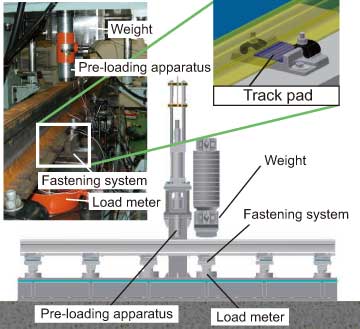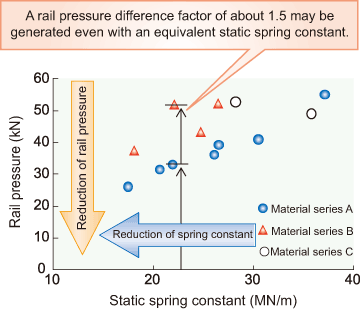3. Evaluation techniques for the buffering performance of track pads
- RTRI developed apparatus to conduct impact experiments taking into account the load conditions of actual tracks.
- It also developed a technique to evaluate the buffering performance of track pads by measuring impact response variables such as rail pressure using the apparatus for impact experiments
The force acting between rails and wheels operates as an impact load in the event of unevenness on the rail top surface or the wheel tread or if there is track irregularity, and this load becomes a major factor increasing vibration, noise and breakage of tracks. One countermeasure involving the reduction of rail support spring constants within a range that allows safe running was implemented using track pads, which is comparatively simple from a construction point of view. However, there is no conventional technique to quantitatively evaluate the buffering performance of track pads against impact loads.
Accordingly, RTRI developed a method to evaluate the buffering performance of track pads by measuring the rail pressure (i.e., the force acting on track pads) against impact loads using the newly developed apparatus for impact experiments (Fig. 1). This apparatus is used to create excitation with impact by means of a weight (i.e., a simulated wheel) under conditions where a force corresponding to the static wheel load has been previously applied to a rail supported by six fastening systems.
Measuring the rail pressure on three kinds of track pads with different materials, shapes, etc. revealed a correlation between the static spring constant and rail pressure. Additionally, comparison of material series A and material series B showed a rail pressure difference factor of up to 1.5 even with an equivalent static spring constant (Fig. 2). As a lower rail pressure results in a reduced likelihood of track breakage, it is clear that the buffering performance of track pads is high. Measuring rail pressure using the apparatus developed in this study allows evaluation of the buffering performance of track pads against impact loads.
In future work, RTRI plans to utilize this evaluation technique to assess deterioration in aged structures and to support the development of materials.
 Fig. 1 Impact experiment apparatus developed
Fig. 1 Impact experiment apparatus developed Fig. 2 Relationship between rail pressure and static spring constant
Fig. 2 Relationship between rail pressure and static spring constant